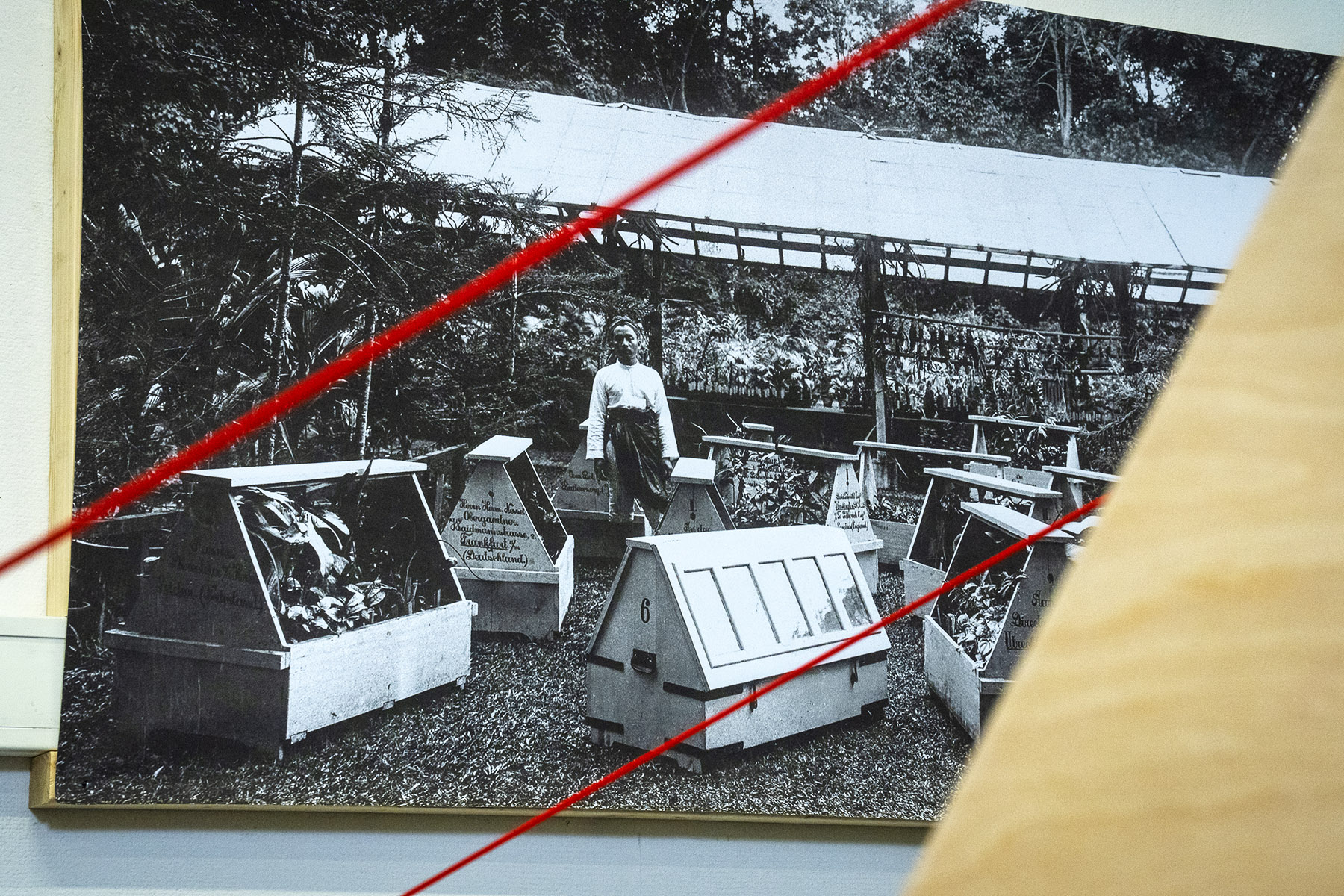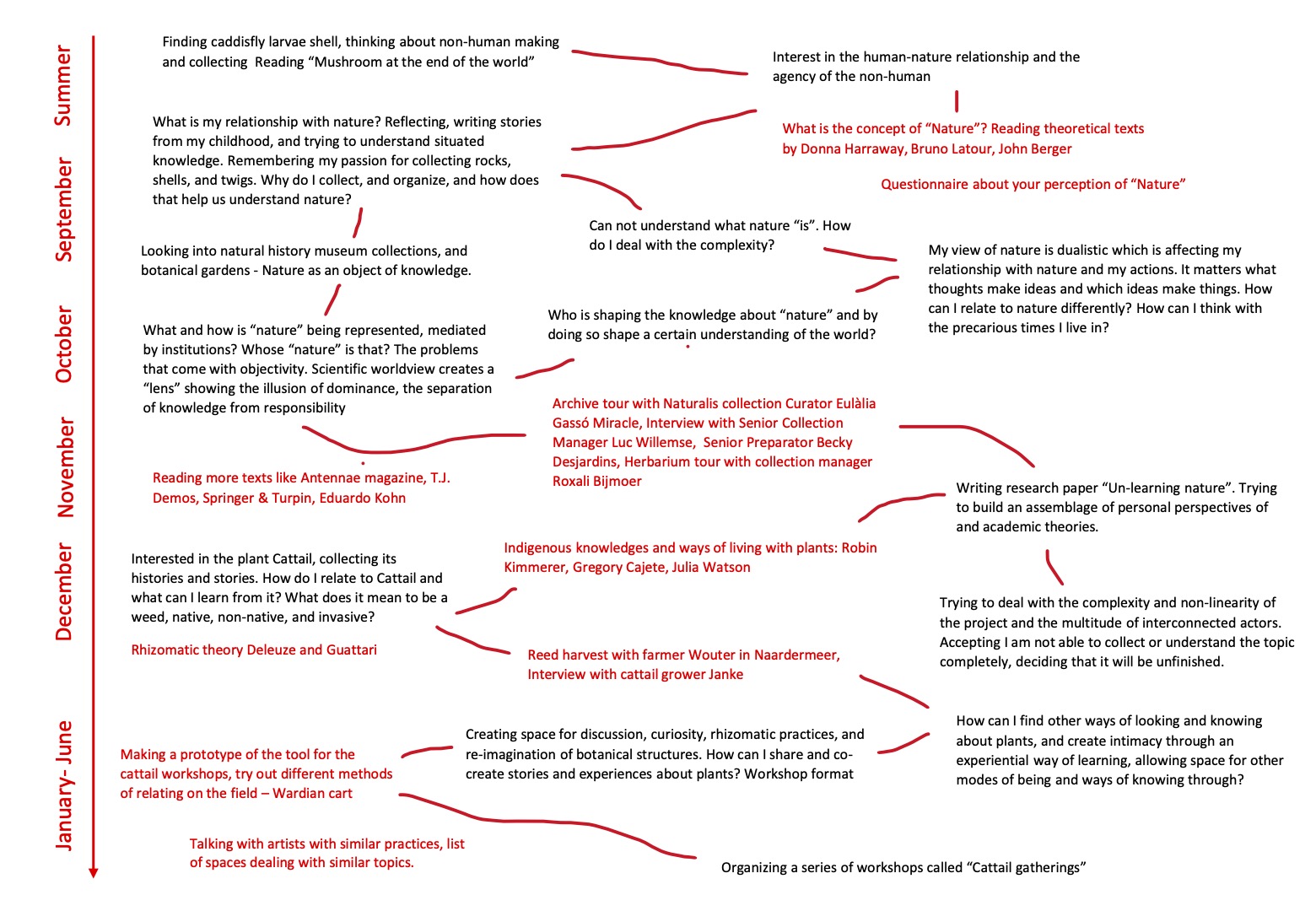Unlearning botanical narratives
Cattail Gatherings
–
Nina Škerjanc
Cattail Gatherings
–
Nina Škerjanc
Background, Research & Process
Since I was a child I had a fascination for collecting everything from rocks to twigs and slowly build my personal cabinet of curiosity. Recently I recalled this habit when I met a fellow collector: an insect known as 'Caddisfly larvae'. Even though we collected for different purposes the questions about collections arose: what does it mean to collect specimens for the purpose of representing and creating knowledge about 'Nature'?
![Wardian cases were used to transport live plants from the Buitenzorg Botanic Gardens, Java, in 1904. Collection Nationaal Van Wereldculturen TM-10010760.]()
By looking closer at natural history museums and botanical gardens I realized that institutional collections are built on a certain set of ideas, that affect our perspective and relationship with non-human worlds. The ideological dualisms embedded in my culture and history are directly related to the nature/culture divide, which materializes in the world through our actions. By using collecting as a design method, I wanted to reproduce these dualisms and explore the effect of those ideas to gain a better understanding of the gradients between ideological divides. I decided to facilitate a workshop series called 'Cattail gatherings', where we create, share and learn in an experiential and sensorial way while being in the plant’s environment. In these workshops, we look at the cattails not as a passive specimen but as a being that carries stories and contributes to the creation of knowledge.
![Gentle cyanotype making: mapping technique part of the Cattail Gatherings workshop.]()
In the first semester of the second year (from September until January) students are asked to develop their initial research questions and develop their research in a ‘research document’, which then leads to their graduation work in the second semester.
Research document: ‘Unlearning Nature: Re-imagining our relationship with nature’
My research is an attempt at unpacking my relationship with 'nature' by tracing how our understanding of it has changed throughout history. To better understand why I know nature in a context separated from 'human', I examined how dualisms were produced and how that affects the way I think, make, and relate to nature and culture. Whose nature do I know, from where and how? The fast-changing pace of the environment we live in calls for re-thinking the ways we learn and relate to the concept of 'nature'. To be able to situate ourselves in the world we first need to become an active part of it by thinking with other actors in our environment and engaging in dialogues. How can we re-frame natural heritage through embodied and experiential knowledge based on a partial and never complete view, fluid modalities of thinking, and multiplicities?
This map offers an insight into the way the research trajectory evolved throughout the year: the questions that have been raised, the people, the books and the references involved, the methods used, and, finally, the materialization of the project.
![]()
︎︎︎Download Process Map
Since I was a child I had a fascination for collecting everything from rocks to twigs and slowly build my personal cabinet of curiosity. Recently I recalled this habit when I met a fellow collector: an insect known as 'Caddisfly larvae'. Even though we collected for different purposes the questions about collections arose: what does it mean to collect specimens for the purpose of representing and creating knowledge about 'Nature'?

By looking closer at natural history museums and botanical gardens I realized that institutional collections are built on a certain set of ideas, that affect our perspective and relationship with non-human worlds. The ideological dualisms embedded in my culture and history are directly related to the nature/culture divide, which materializes in the world through our actions. By using collecting as a design method, I wanted to reproduce these dualisms and explore the effect of those ideas to gain a better understanding of the gradients between ideological divides. I decided to facilitate a workshop series called 'Cattail gatherings', where we create, share and learn in an experiential and sensorial way while being in the plant’s environment. In these workshops, we look at the cattails not as a passive specimen but as a being that carries stories and contributes to the creation of knowledge.

In the first semester of the second year (from September until January) students are asked to develop their initial research questions and develop their research in a ‘research document’, which then leads to their graduation work in the second semester.
Research document: ‘Unlearning Nature: Re-imagining our relationship with nature’
My research is an attempt at unpacking my relationship with 'nature' by tracing how our understanding of it has changed throughout history. To better understand why I know nature in a context separated from 'human', I examined how dualisms were produced and how that affects the way I think, make, and relate to nature and culture. Whose nature do I know, from where and how? The fast-changing pace of the environment we live in calls for re-thinking the ways we learn and relate to the concept of 'nature'. To be able to situate ourselves in the world we first need to become an active part of it by thinking with other actors in our environment and engaging in dialogues. How can we re-frame natural heritage through embodied and experiential knowledge based on a partial and never complete view, fluid modalities of thinking, and multiplicities?
This map offers an insight into the way the research trajectory evolved throughout the year: the questions that have been raised, the people, the books and the references involved, the methods used, and, finally, the materialization of the project.

︎︎︎Download Process Map